Prevalence and Impact of Stigma on Mental Health
VerifiedAdded on 2022/12/15
|12
|2986
|80
AI Summary
This essay discusses the prevalence and impact of stigma and discrimination on individuals with mental health conditions. It explores how Australia addresses stigma to protect the rights of mental health consumers.
Contribute Materials
Your contribution can guide someone’s learning journey. Share your
documents today.
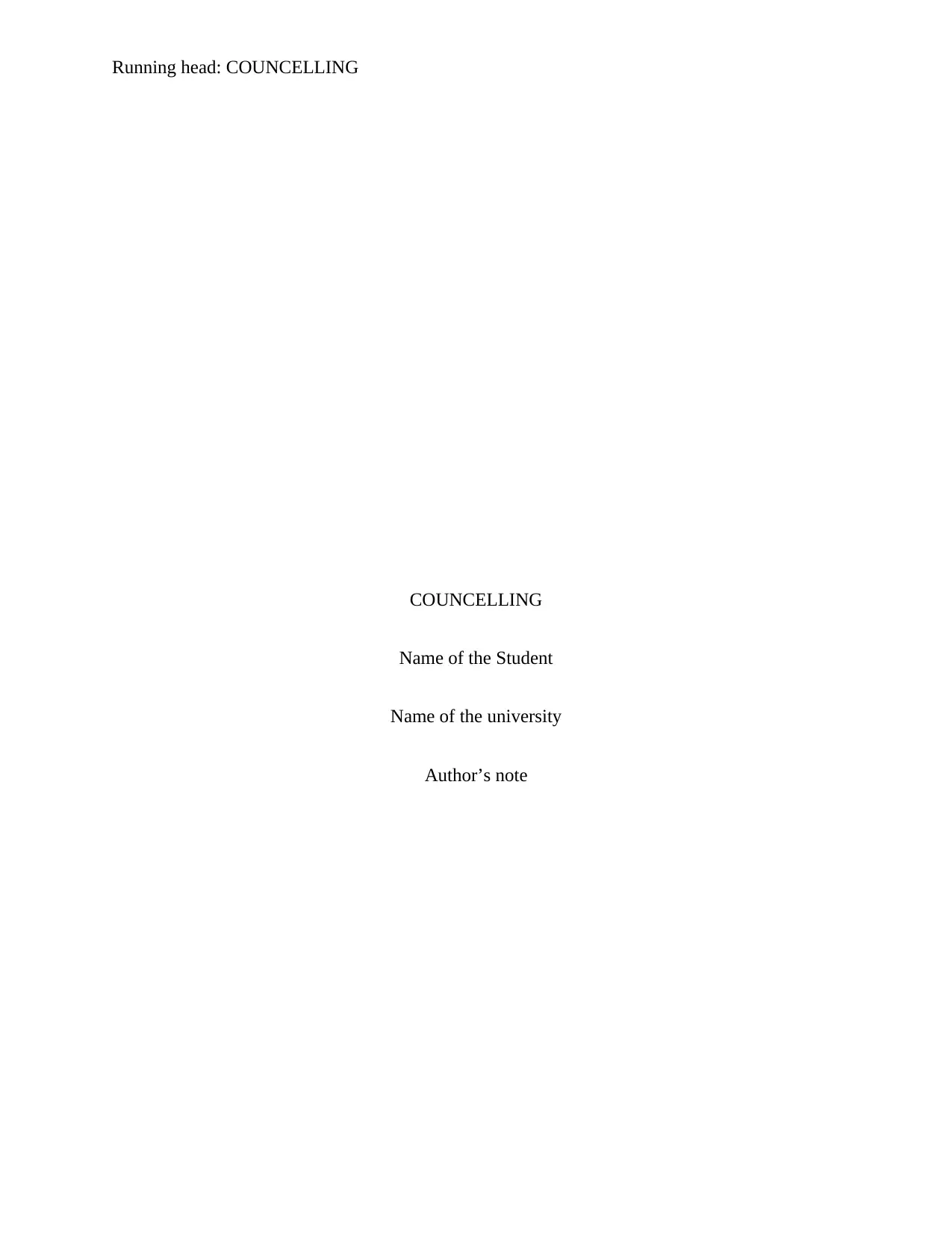
Running head: COUNCELLING
COUNCELLING
Name of the Student
Name of the university
Author’s note
COUNCELLING
Name of the Student
Name of the university
Author’s note
Secure Best Marks with AI Grader
Need help grading? Try our AI Grader for instant feedback on your assignments.
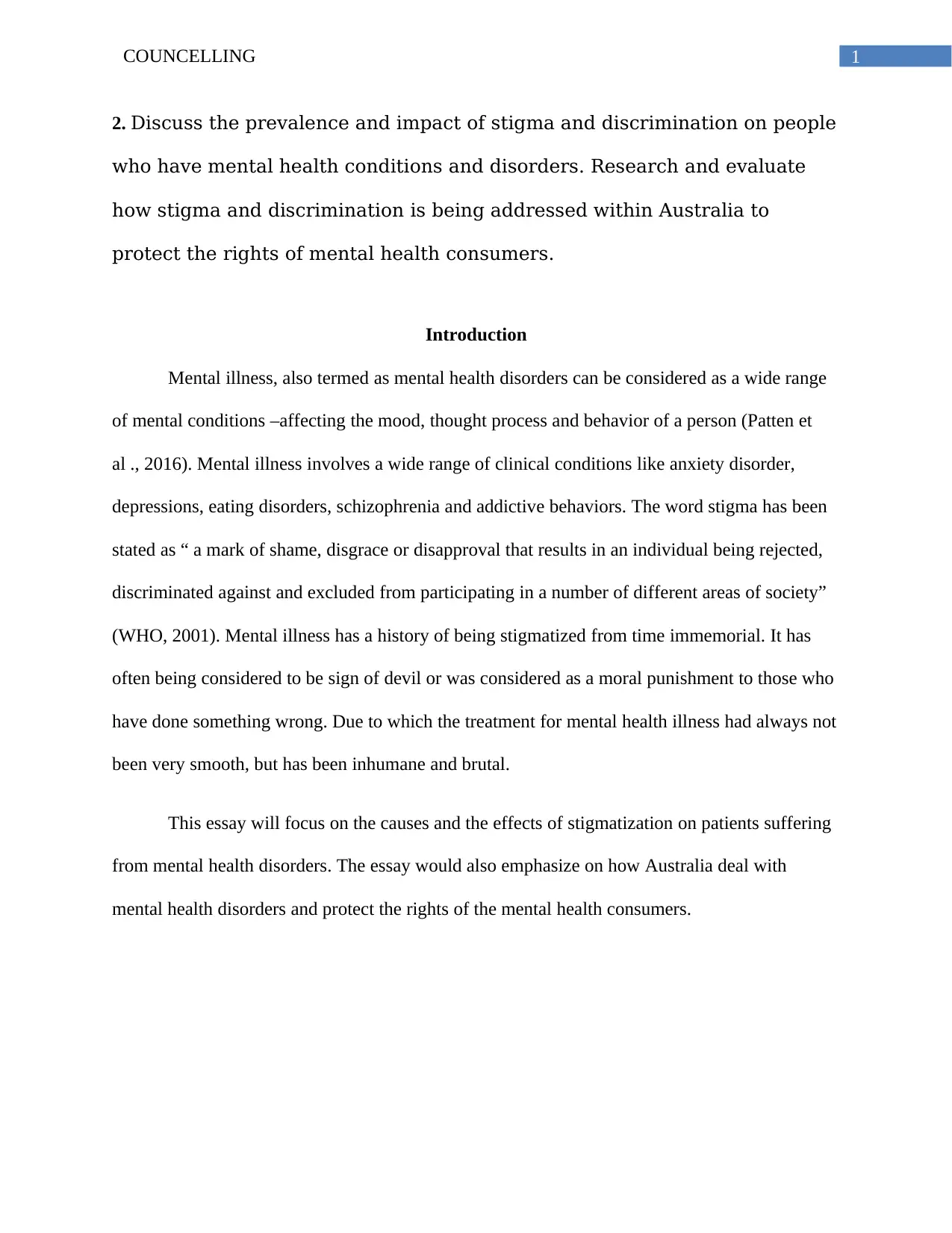
1COUNCELLING
2. Discuss the prevalence and impact of stigma and discrimination on people
who have mental health conditions and disorders. Research and evaluate
how stigma and discrimination is being addressed within Australia to
protect the rights of mental health consumers.
Introduction
Mental illness, also termed as mental health disorders can be considered as a wide range
of mental conditions –affecting the mood, thought process and behavior of a person (Patten et
al ., 2016). Mental illness involves a wide range of clinical conditions like anxiety disorder,
depressions, eating disorders, schizophrenia and addictive behaviors. The word stigma has been
stated as “ a mark of shame, disgrace or disapproval that results in an individual being rejected,
discriminated against and excluded from participating in a number of different areas of society”
(WHO, 2001). Mental illness has a history of being stigmatized from time immemorial. It has
often being considered to be sign of devil or was considered as a moral punishment to those who
have done something wrong. Due to which the treatment for mental health illness had always not
been very smooth, but has been inhumane and brutal.
This essay will focus on the causes and the effects of stigmatization on patients suffering
from mental health disorders. The essay would also emphasize on how Australia deal with
mental health disorders and protect the rights of the mental health consumers.
2. Discuss the prevalence and impact of stigma and discrimination on people
who have mental health conditions and disorders. Research and evaluate
how stigma and discrimination is being addressed within Australia to
protect the rights of mental health consumers.
Introduction
Mental illness, also termed as mental health disorders can be considered as a wide range
of mental conditions –affecting the mood, thought process and behavior of a person (Patten et
al ., 2016). Mental illness involves a wide range of clinical conditions like anxiety disorder,
depressions, eating disorders, schizophrenia and addictive behaviors. The word stigma has been
stated as “ a mark of shame, disgrace or disapproval that results in an individual being rejected,
discriminated against and excluded from participating in a number of different areas of society”
(WHO, 2001). Mental illness has a history of being stigmatized from time immemorial. It has
often being considered to be sign of devil or was considered as a moral punishment to those who
have done something wrong. Due to which the treatment for mental health illness had always not
been very smooth, but has been inhumane and brutal.
This essay will focus on the causes and the effects of stigmatization on patients suffering
from mental health disorders. The essay would also emphasize on how Australia deal with
mental health disorders and protect the rights of the mental health consumers.
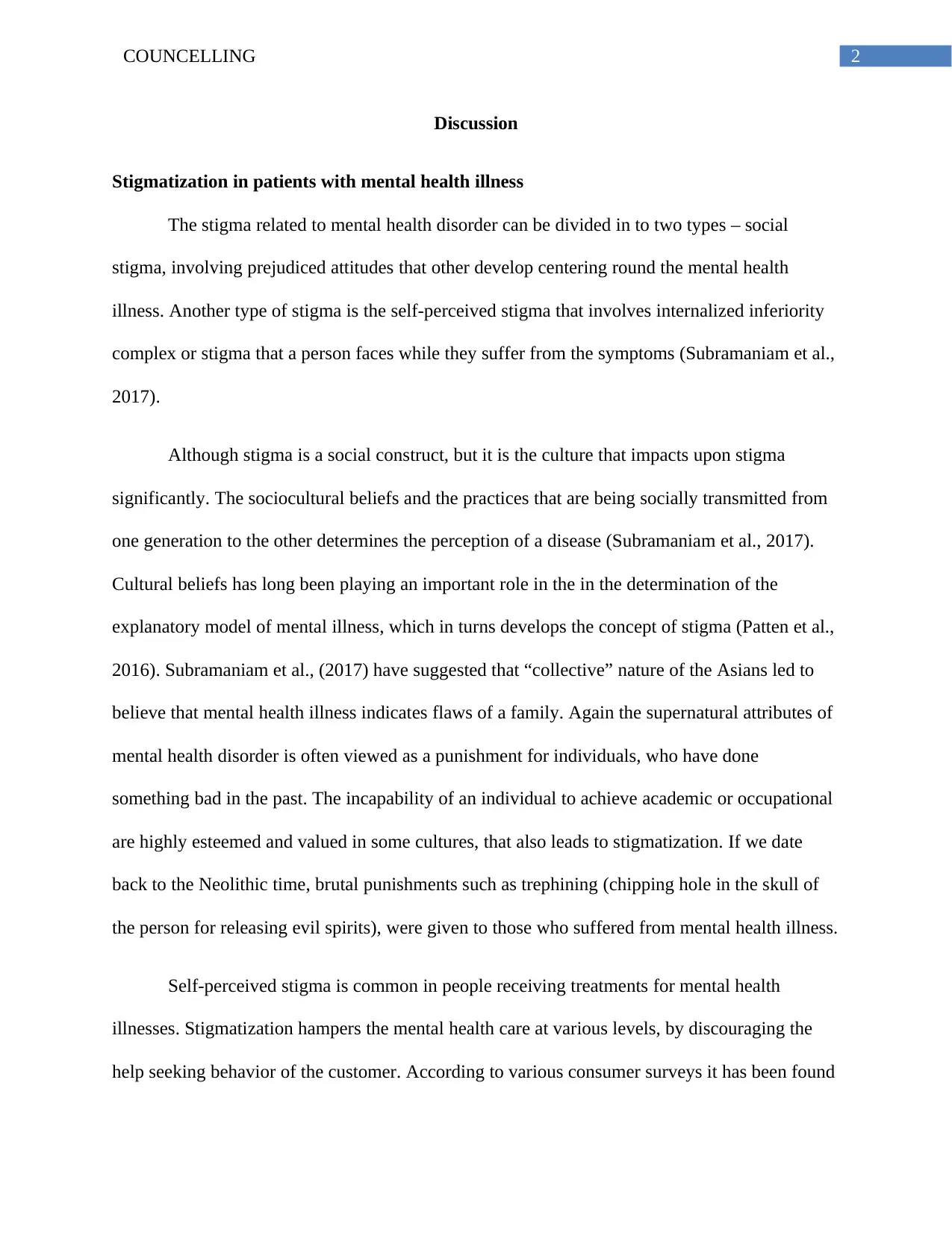
2COUNCELLING
Discussion
Stigmatization in patients with mental health illness
The stigma related to mental health disorder can be divided in to two types – social
stigma, involving prejudiced attitudes that other develop centering round the mental health
illness. Another type of stigma is the self-perceived stigma that involves internalized inferiority
complex or stigma that a person faces while they suffer from the symptoms (Subramaniam et al.,
2017).
Although stigma is a social construct, but it is the culture that impacts upon stigma
significantly. The sociocultural beliefs and the practices that are being socially transmitted from
one generation to the other determines the perception of a disease (Subramaniam et al., 2017).
Cultural beliefs has long been playing an important role in the in the determination of the
explanatory model of mental illness, which in turns develops the concept of stigma (Patten et al.,
2016). Subramaniam et al., (2017) have suggested that “collective” nature of the Asians led to
believe that mental health illness indicates flaws of a family. Again the supernatural attributes of
mental health disorder is often viewed as a punishment for individuals, who have done
something bad in the past. The incapability of an individual to achieve academic or occupational
are highly esteemed and valued in some cultures, that also leads to stigmatization. If we date
back to the Neolithic time, brutal punishments such as trephining (chipping hole in the skull of
the person for releasing evil spirits), were given to those who suffered from mental health illness.
Self-perceived stigma is common in people receiving treatments for mental health
illnesses. Stigmatization hampers the mental health care at various levels, by discouraging the
help seeking behavior of the customer. According to various consumer surveys it has been found
Discussion
Stigmatization in patients with mental health illness
The stigma related to mental health disorder can be divided in to two types – social
stigma, involving prejudiced attitudes that other develop centering round the mental health
illness. Another type of stigma is the self-perceived stigma that involves internalized inferiority
complex or stigma that a person faces while they suffer from the symptoms (Subramaniam et al.,
2017).
Although stigma is a social construct, but it is the culture that impacts upon stigma
significantly. The sociocultural beliefs and the practices that are being socially transmitted from
one generation to the other determines the perception of a disease (Subramaniam et al., 2017).
Cultural beliefs has long been playing an important role in the in the determination of the
explanatory model of mental illness, which in turns develops the concept of stigma (Patten et al.,
2016). Subramaniam et al., (2017) have suggested that “collective” nature of the Asians led to
believe that mental health illness indicates flaws of a family. Again the supernatural attributes of
mental health disorder is often viewed as a punishment for individuals, who have done
something bad in the past. The incapability of an individual to achieve academic or occupational
are highly esteemed and valued in some cultures, that also leads to stigmatization. If we date
back to the Neolithic time, brutal punishments such as trephining (chipping hole in the skull of
the person for releasing evil spirits), were given to those who suffered from mental health illness.
Self-perceived stigma is common in people receiving treatments for mental health
illnesses. Stigmatization hampers the mental health care at various levels, by discouraging the
help seeking behavior of the customer. According to various consumer surveys it has been found
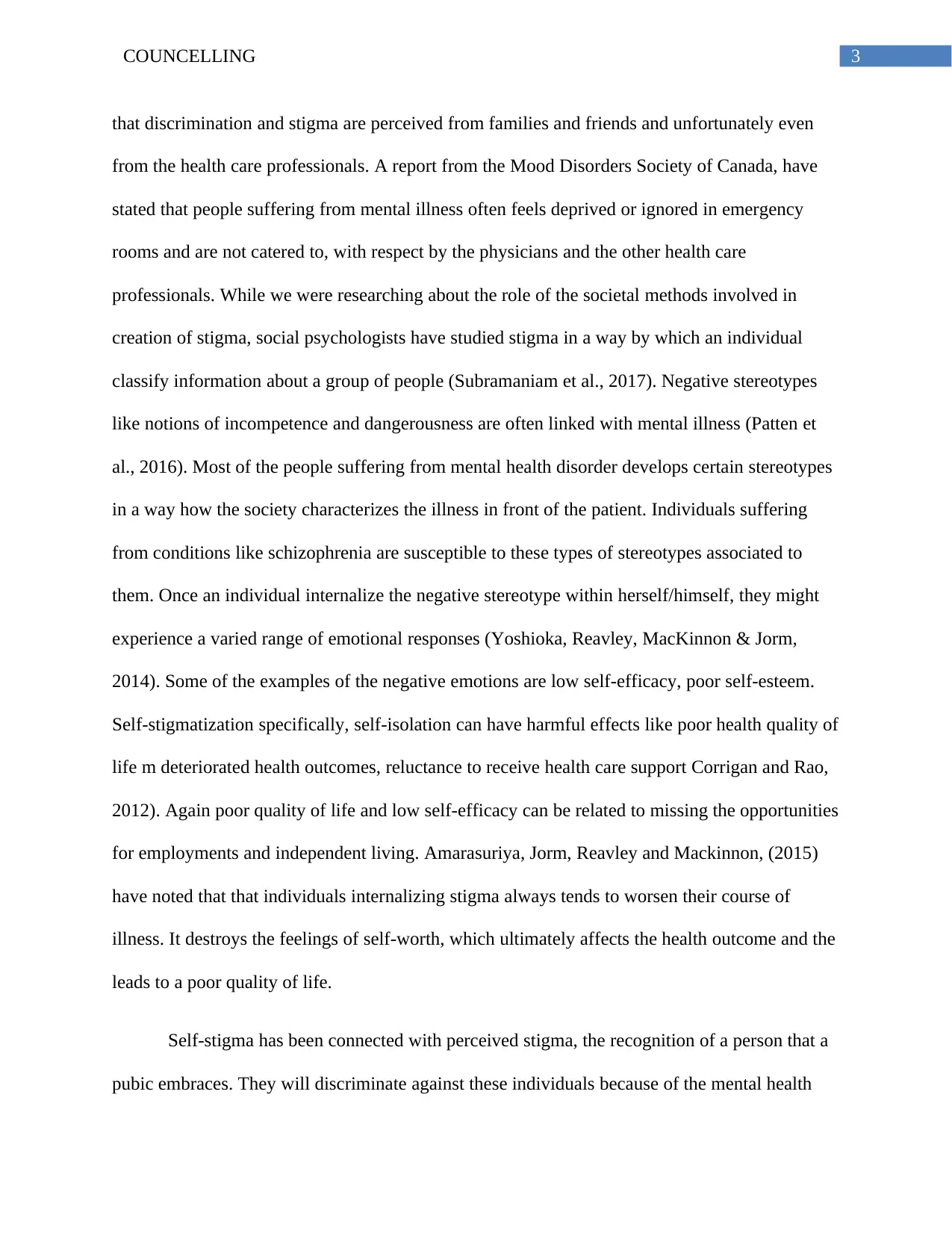
3COUNCELLING
that discrimination and stigma are perceived from families and friends and unfortunately even
from the health care professionals. A report from the Mood Disorders Society of Canada, have
stated that people suffering from mental illness often feels deprived or ignored in emergency
rooms and are not catered to, with respect by the physicians and the other health care
professionals. While we were researching about the role of the societal methods involved in
creation of stigma, social psychologists have studied stigma in a way by which an individual
classify information about a group of people (Subramaniam et al., 2017). Negative stereotypes
like notions of incompetence and dangerousness are often linked with mental illness (Patten et
al., 2016). Most of the people suffering from mental health disorder develops certain stereotypes
in a way how the society characterizes the illness in front of the patient. Individuals suffering
from conditions like schizophrenia are susceptible to these types of stereotypes associated to
them. Once an individual internalize the negative stereotype within herself/himself, they might
experience a varied range of emotional responses (Yoshioka, Reavley, MacKinnon & Jorm,
2014). Some of the examples of the negative emotions are low self-efficacy, poor self-esteem.
Self-stigmatization specifically, self-isolation can have harmful effects like poor health quality of
life m deteriorated health outcomes, reluctance to receive health care support Corrigan and Rao,
2012). Again poor quality of life and low self-efficacy can be related to missing the opportunities
for employments and independent living. Amarasuriya, Jorm, Reavley and Mackinnon, (2015)
have noted that that individuals internalizing stigma always tends to worsen their course of
illness. It destroys the feelings of self-worth, which ultimately affects the health outcome and the
leads to a poor quality of life.
Self-stigma has been connected with perceived stigma, the recognition of a person that a
pubic embraces. They will discriminate against these individuals because of the mental health
that discrimination and stigma are perceived from families and friends and unfortunately even
from the health care professionals. A report from the Mood Disorders Society of Canada, have
stated that people suffering from mental illness often feels deprived or ignored in emergency
rooms and are not catered to, with respect by the physicians and the other health care
professionals. While we were researching about the role of the societal methods involved in
creation of stigma, social psychologists have studied stigma in a way by which an individual
classify information about a group of people (Subramaniam et al., 2017). Negative stereotypes
like notions of incompetence and dangerousness are often linked with mental illness (Patten et
al., 2016). Most of the people suffering from mental health disorder develops certain stereotypes
in a way how the society characterizes the illness in front of the patient. Individuals suffering
from conditions like schizophrenia are susceptible to these types of stereotypes associated to
them. Once an individual internalize the negative stereotype within herself/himself, they might
experience a varied range of emotional responses (Yoshioka, Reavley, MacKinnon & Jorm,
2014). Some of the examples of the negative emotions are low self-efficacy, poor self-esteem.
Self-stigmatization specifically, self-isolation can have harmful effects like poor health quality of
life m deteriorated health outcomes, reluctance to receive health care support Corrigan and Rao,
2012). Again poor quality of life and low self-efficacy can be related to missing the opportunities
for employments and independent living. Amarasuriya, Jorm, Reavley and Mackinnon, (2015)
have noted that that individuals internalizing stigma always tends to worsen their course of
illness. It destroys the feelings of self-worth, which ultimately affects the health outcome and the
leads to a poor quality of life.
Self-stigma has been connected with perceived stigma, the recognition of a person that a
pubic embraces. They will discriminate against these individuals because of the mental health
Secure Best Marks with AI Grader
Need help grading? Try our AI Grader for instant feedback on your assignments.
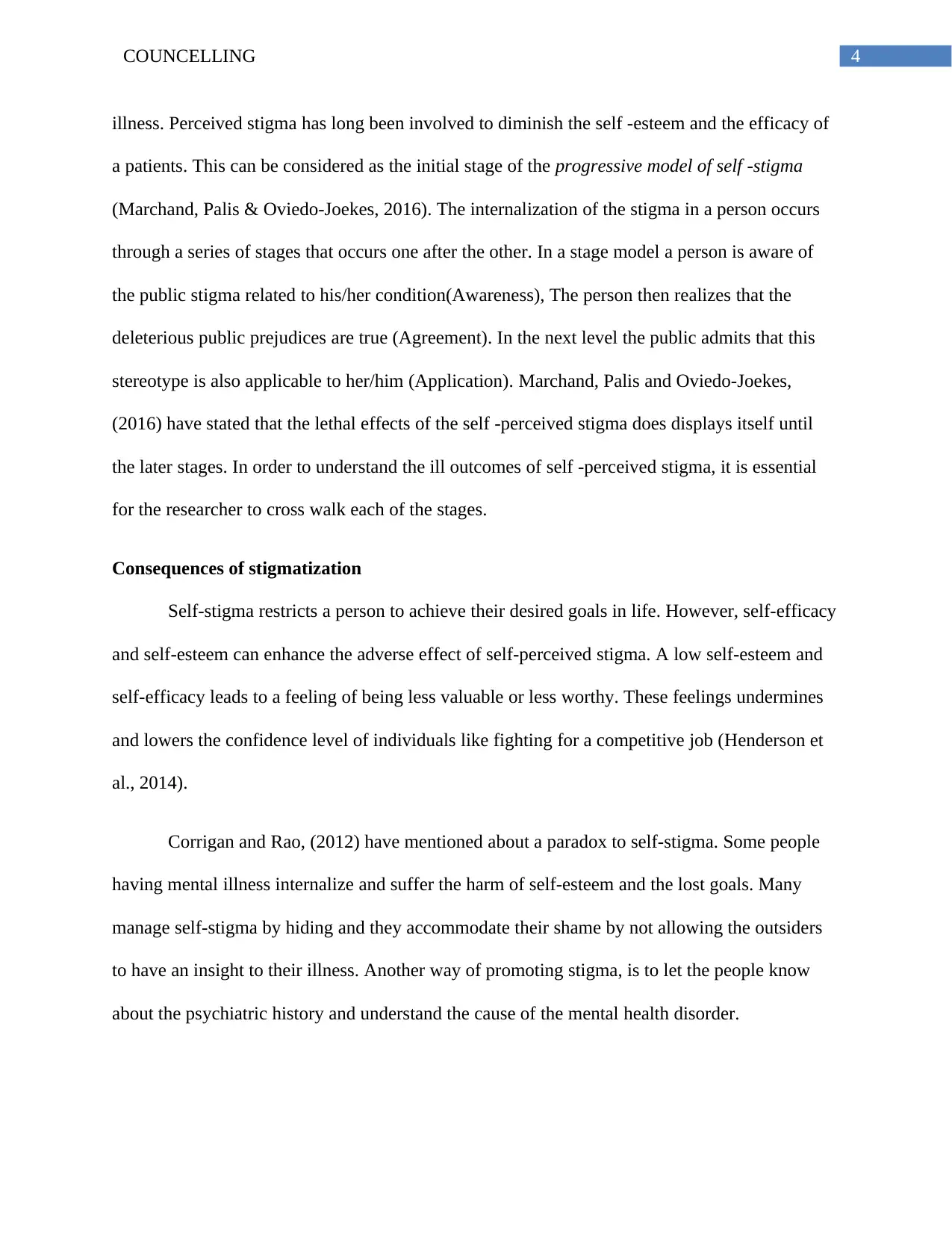
4COUNCELLING
illness. Perceived stigma has long been involved to diminish the self -esteem and the efficacy of
a patients. This can be considered as the initial stage of the progressive model of self -stigma
(Marchand, Palis & Oviedo-Joekes, 2016). The internalization of the stigma in a person occurs
through a series of stages that occurs one after the other. In a stage model a person is aware of
the public stigma related to his/her condition(Awareness), The person then realizes that the
deleterious public prejudices are true (Agreement). In the next level the public admits that this
stereotype is also applicable to her/him (Application). Marchand, Palis and Oviedo-Joekes,
(2016) have stated that the lethal effects of the self -perceived stigma does displays itself until
the later stages. In order to understand the ill outcomes of self -perceived stigma, it is essential
for the researcher to cross walk each of the stages.
Consequences of stigmatization
Self-stigma restricts a person to achieve their desired goals in life. However, self-efficacy
and self-esteem can enhance the adverse effect of self-perceived stigma. A low self-esteem and
self-efficacy leads to a feeling of being less valuable or less worthy. These feelings undermines
and lowers the confidence level of individuals like fighting for a competitive job (Henderson et
al., 2014).
Corrigan and Rao, (2012) have mentioned about a paradox to self-stigma. Some people
having mental illness internalize and suffer the harm of self-esteem and the lost goals. Many
manage self-stigma by hiding and they accommodate their shame by not allowing the outsiders
to have an insight to their illness. Another way of promoting stigma, is to let the people know
about the psychiatric history and understand the cause of the mental health disorder.
illness. Perceived stigma has long been involved to diminish the self -esteem and the efficacy of
a patients. This can be considered as the initial stage of the progressive model of self -stigma
(Marchand, Palis & Oviedo-Joekes, 2016). The internalization of the stigma in a person occurs
through a series of stages that occurs one after the other. In a stage model a person is aware of
the public stigma related to his/her condition(Awareness), The person then realizes that the
deleterious public prejudices are true (Agreement). In the next level the public admits that this
stereotype is also applicable to her/him (Application). Marchand, Palis and Oviedo-Joekes,
(2016) have stated that the lethal effects of the self -perceived stigma does displays itself until
the later stages. In order to understand the ill outcomes of self -perceived stigma, it is essential
for the researcher to cross walk each of the stages.
Consequences of stigmatization
Self-stigma restricts a person to achieve their desired goals in life. However, self-efficacy
and self-esteem can enhance the adverse effect of self-perceived stigma. A low self-esteem and
self-efficacy leads to a feeling of being less valuable or less worthy. These feelings undermines
and lowers the confidence level of individuals like fighting for a competitive job (Henderson et
al., 2014).
Corrigan and Rao, (2012) have mentioned about a paradox to self-stigma. Some people
having mental illness internalize and suffer the harm of self-esteem and the lost goals. Many
manage self-stigma by hiding and they accommodate their shame by not allowing the outsiders
to have an insight to their illness. Another way of promoting stigma, is to let the people know
about the psychiatric history and understand the cause of the mental health disorder.
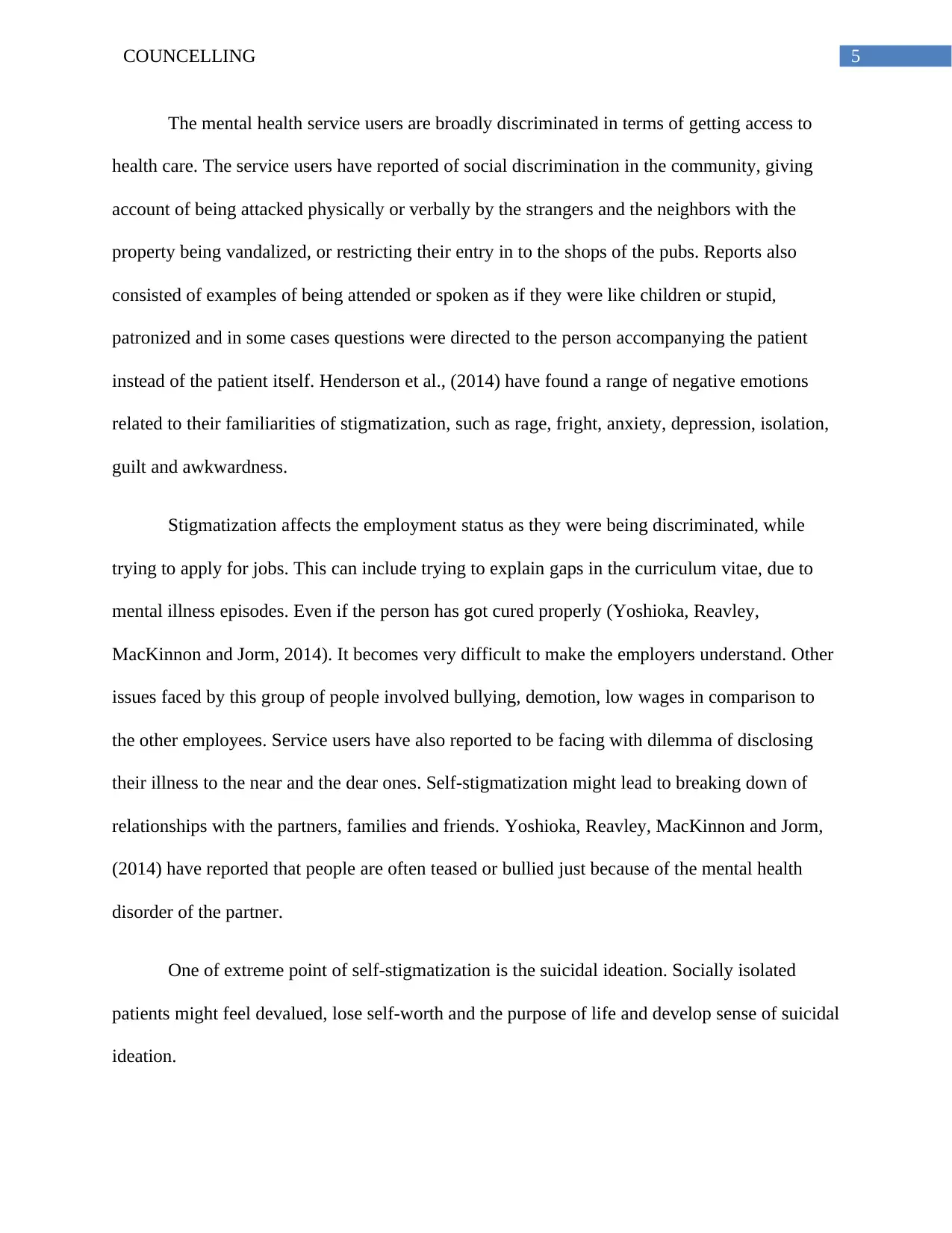
5COUNCELLING
The mental health service users are broadly discriminated in terms of getting access to
health care. The service users have reported of social discrimination in the community, giving
account of being attacked physically or verbally by the strangers and the neighbors with the
property being vandalized, or restricting their entry in to the shops of the pubs. Reports also
consisted of examples of being attended or spoken as if they were like children or stupid,
patronized and in some cases questions were directed to the person accompanying the patient
instead of the patient itself. Henderson et al., (2014) have found a range of negative emotions
related to their familiarities of stigmatization, such as rage, fright, anxiety, depression, isolation,
guilt and awkwardness.
Stigmatization affects the employment status as they were being discriminated, while
trying to apply for jobs. This can include trying to explain gaps in the curriculum vitae, due to
mental illness episodes. Even if the person has got cured properly (Yoshioka, Reavley,
MacKinnon and Jorm, 2014). It becomes very difficult to make the employers understand. Other
issues faced by this group of people involved bullying, demotion, low wages in comparison to
the other employees. Service users have also reported to be facing with dilemma of disclosing
their illness to the near and the dear ones. Self-stigmatization might lead to breaking down of
relationships with the partners, families and friends. Yoshioka, Reavley, MacKinnon and Jorm,
(2014) have reported that people are often teased or bullied just because of the mental health
disorder of the partner.
One of extreme point of self-stigmatization is the suicidal ideation. Socially isolated
patients might feel devalued, lose self-worth and the purpose of life and develop sense of suicidal
ideation.
The mental health service users are broadly discriminated in terms of getting access to
health care. The service users have reported of social discrimination in the community, giving
account of being attacked physically or verbally by the strangers and the neighbors with the
property being vandalized, or restricting their entry in to the shops of the pubs. Reports also
consisted of examples of being attended or spoken as if they were like children or stupid,
patronized and in some cases questions were directed to the person accompanying the patient
instead of the patient itself. Henderson et al., (2014) have found a range of negative emotions
related to their familiarities of stigmatization, such as rage, fright, anxiety, depression, isolation,
guilt and awkwardness.
Stigmatization affects the employment status as they were being discriminated, while
trying to apply for jobs. This can include trying to explain gaps in the curriculum vitae, due to
mental illness episodes. Even if the person has got cured properly (Yoshioka, Reavley,
MacKinnon and Jorm, 2014). It becomes very difficult to make the employers understand. Other
issues faced by this group of people involved bullying, demotion, low wages in comparison to
the other employees. Service users have also reported to be facing with dilemma of disclosing
their illness to the near and the dear ones. Self-stigmatization might lead to breaking down of
relationships with the partners, families and friends. Yoshioka, Reavley, MacKinnon and Jorm,
(2014) have reported that people are often teased or bullied just because of the mental health
disorder of the partner.
One of extreme point of self-stigmatization is the suicidal ideation. Socially isolated
patients might feel devalued, lose self-worth and the purpose of life and develop sense of suicidal
ideation.
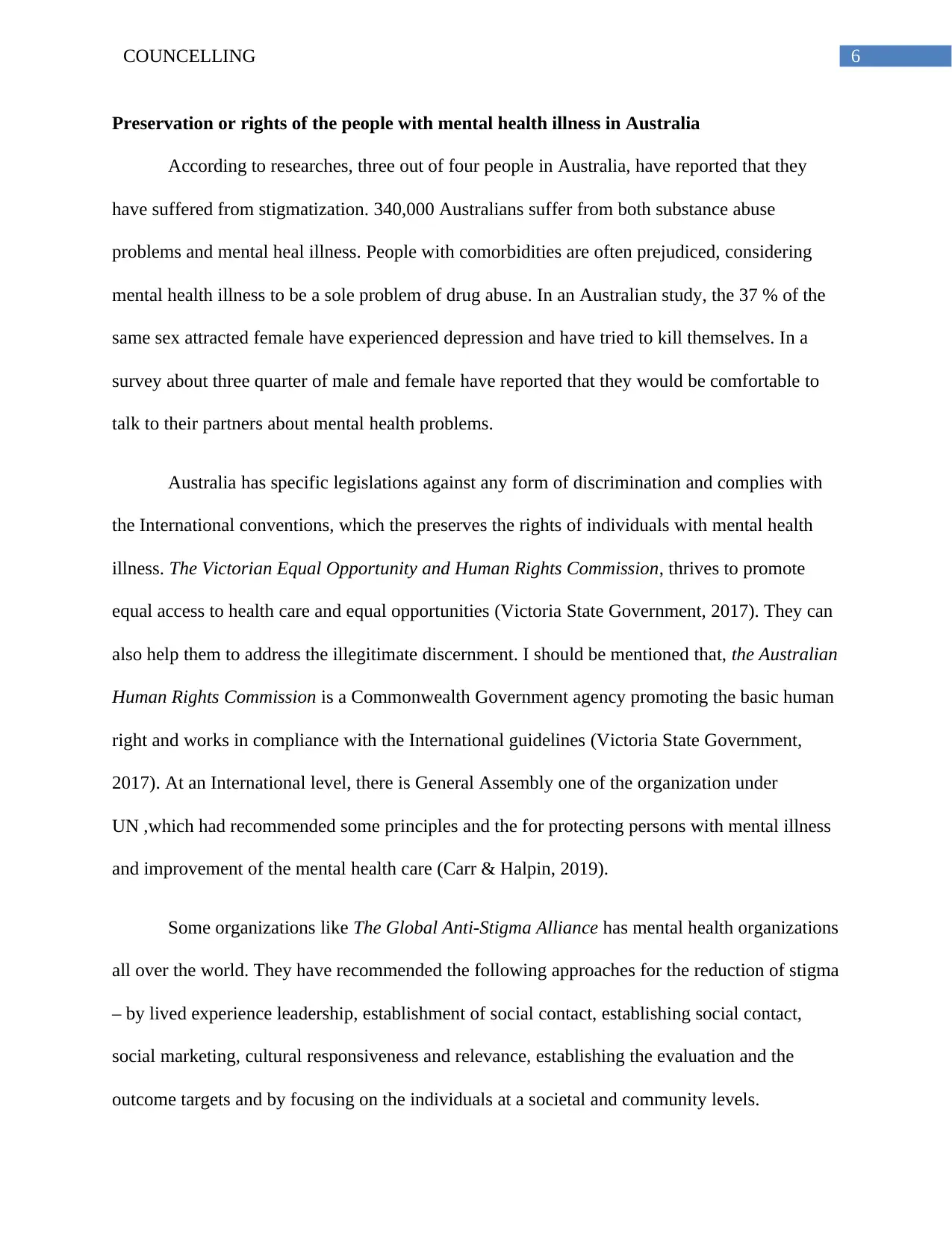
6COUNCELLING
Preservation or rights of the people with mental health illness in Australia
According to researches, three out of four people in Australia, have reported that they
have suffered from stigmatization. 340,000 Australians suffer from both substance abuse
problems and mental heal illness. People with comorbidities are often prejudiced, considering
mental health illness to be a sole problem of drug abuse. In an Australian study, the 37 % of the
same sex attracted female have experienced depression and have tried to kill themselves. In a
survey about three quarter of male and female have reported that they would be comfortable to
talk to their partners about mental health problems.
Australia has specific legislations against any form of discrimination and complies with
the International conventions, which the preserves the rights of individuals with mental health
illness. The Victorian Equal Opportunity and Human Rights Commission, thrives to promote
equal access to health care and equal opportunities (Victoria State Government, 2017). They can
also help them to address the illegitimate discernment. I should be mentioned that, the Australian
Human Rights Commission is a Commonwealth Government agency promoting the basic human
right and works in compliance with the International guidelines (Victoria State Government,
2017). At an International level, there is General Assembly one of the organization under
UN ,which had recommended some principles and the for protecting persons with mental illness
and improvement of the mental health care (Carr & Halpin, 2019).
Some organizations like The Global Anti-Stigma Alliance has mental health organizations
all over the world. They have recommended the following approaches for the reduction of stigma
– by lived experience leadership, establishment of social contact, establishing social contact,
social marketing, cultural responsiveness and relevance, establishing the evaluation and the
outcome targets and by focusing on the individuals at a societal and community levels.
Preservation or rights of the people with mental health illness in Australia
According to researches, three out of four people in Australia, have reported that they
have suffered from stigmatization. 340,000 Australians suffer from both substance abuse
problems and mental heal illness. People with comorbidities are often prejudiced, considering
mental health illness to be a sole problem of drug abuse. In an Australian study, the 37 % of the
same sex attracted female have experienced depression and have tried to kill themselves. In a
survey about three quarter of male and female have reported that they would be comfortable to
talk to their partners about mental health problems.
Australia has specific legislations against any form of discrimination and complies with
the International conventions, which the preserves the rights of individuals with mental health
illness. The Victorian Equal Opportunity and Human Rights Commission, thrives to promote
equal access to health care and equal opportunities (Victoria State Government, 2017). They can
also help them to address the illegitimate discernment. I should be mentioned that, the Australian
Human Rights Commission is a Commonwealth Government agency promoting the basic human
right and works in compliance with the International guidelines (Victoria State Government,
2017). At an International level, there is General Assembly one of the organization under
UN ,which had recommended some principles and the for protecting persons with mental illness
and improvement of the mental health care (Carr & Halpin, 2019).
Some organizations like The Global Anti-Stigma Alliance has mental health organizations
all over the world. They have recommended the following approaches for the reduction of stigma
– by lived experience leadership, establishment of social contact, establishing social contact,
social marketing, cultural responsiveness and relevance, establishing the evaluation and the
outcome targets and by focusing on the individuals at a societal and community levels.
Paraphrase This Document
Need a fresh take? Get an instant paraphrase of this document with our AI Paraphraser
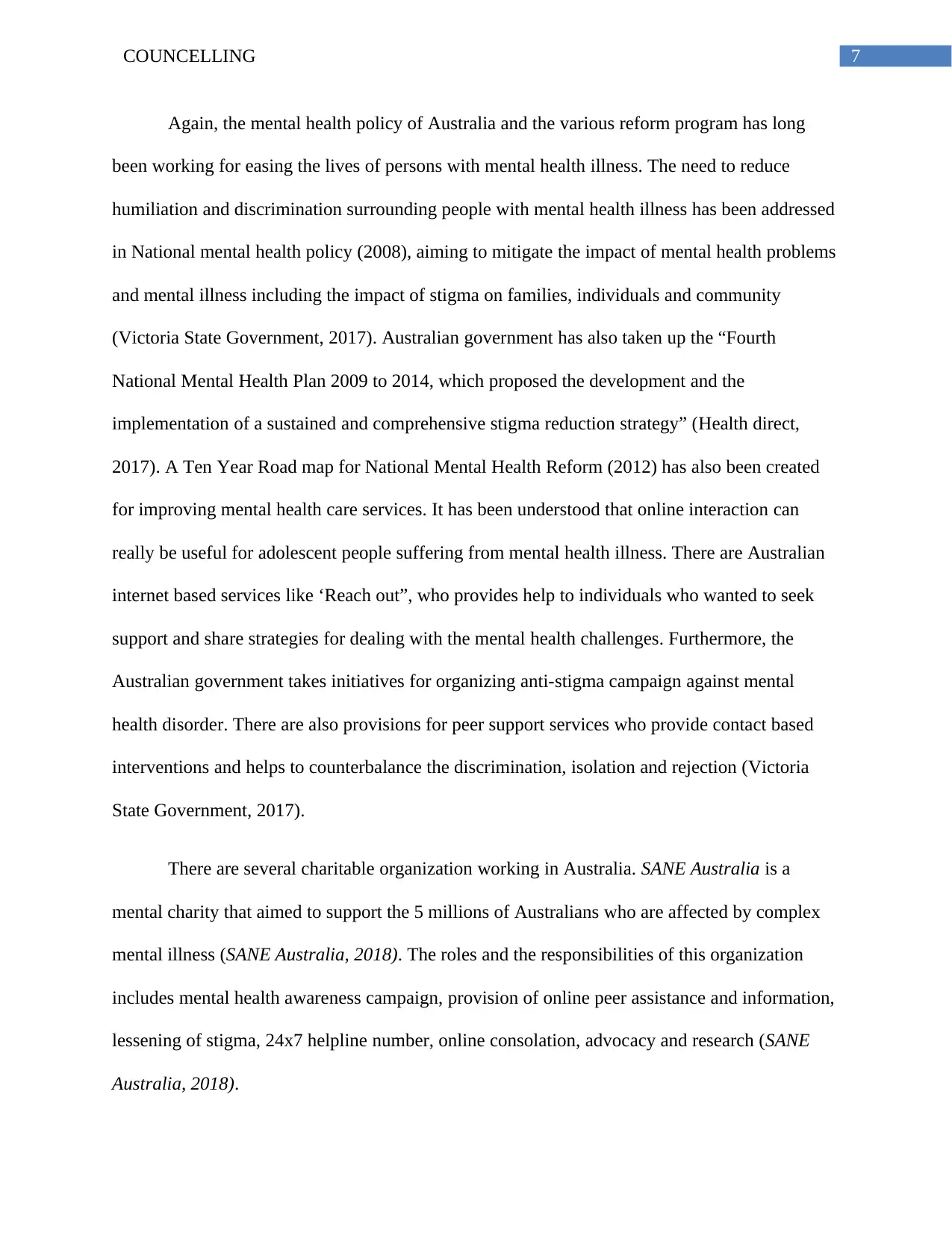
7COUNCELLING
Again, the mental health policy of Australia and the various reform program has long
been working for easing the lives of persons with mental health illness. The need to reduce
humiliation and discrimination surrounding people with mental health illness has been addressed
in National mental health policy (2008), aiming to mitigate the impact of mental health problems
and mental illness including the impact of stigma on families, individuals and community
(Victoria State Government, 2017). Australian government has also taken up the “Fourth
National Mental Health Plan 2009 to 2014, which proposed the development and the
implementation of a sustained and comprehensive stigma reduction strategy” (Health direct,
2017). A Ten Year Road map for National Mental Health Reform (2012) has also been created
for improving mental health care services. It has been understood that online interaction can
really be useful for adolescent people suffering from mental health illness. There are Australian
internet based services like ‘Reach out”, who provides help to individuals who wanted to seek
support and share strategies for dealing with the mental health challenges. Furthermore, the
Australian government takes initiatives for organizing anti-stigma campaign against mental
health disorder. There are also provisions for peer support services who provide contact based
interventions and helps to counterbalance the discrimination, isolation and rejection (Victoria
State Government, 2017).
There are several charitable organization working in Australia. SANE Australia is a
mental charity that aimed to support the 5 millions of Australians who are affected by complex
mental illness (SANE Australia, 2018). The roles and the responsibilities of this organization
includes mental health awareness campaign, provision of online peer assistance and information,
lessening of stigma, 24x7 helpline number, online consolation, advocacy and research (SANE
Australia, 2018).
Again, the mental health policy of Australia and the various reform program has long
been working for easing the lives of persons with mental health illness. The need to reduce
humiliation and discrimination surrounding people with mental health illness has been addressed
in National mental health policy (2008), aiming to mitigate the impact of mental health problems
and mental illness including the impact of stigma on families, individuals and community
(Victoria State Government, 2017). Australian government has also taken up the “Fourth
National Mental Health Plan 2009 to 2014, which proposed the development and the
implementation of a sustained and comprehensive stigma reduction strategy” (Health direct,
2017). A Ten Year Road map for National Mental Health Reform (2012) has also been created
for improving mental health care services. It has been understood that online interaction can
really be useful for adolescent people suffering from mental health illness. There are Australian
internet based services like ‘Reach out”, who provides help to individuals who wanted to seek
support and share strategies for dealing with the mental health challenges. Furthermore, the
Australian government takes initiatives for organizing anti-stigma campaign against mental
health disorder. There are also provisions for peer support services who provide contact based
interventions and helps to counterbalance the discrimination, isolation and rejection (Victoria
State Government, 2017).
There are several charitable organization working in Australia. SANE Australia is a
mental charity that aimed to support the 5 millions of Australians who are affected by complex
mental illness (SANE Australia, 2018). The roles and the responsibilities of this organization
includes mental health awareness campaign, provision of online peer assistance and information,
lessening of stigma, 24x7 helpline number, online consolation, advocacy and research (SANE
Australia, 2018).
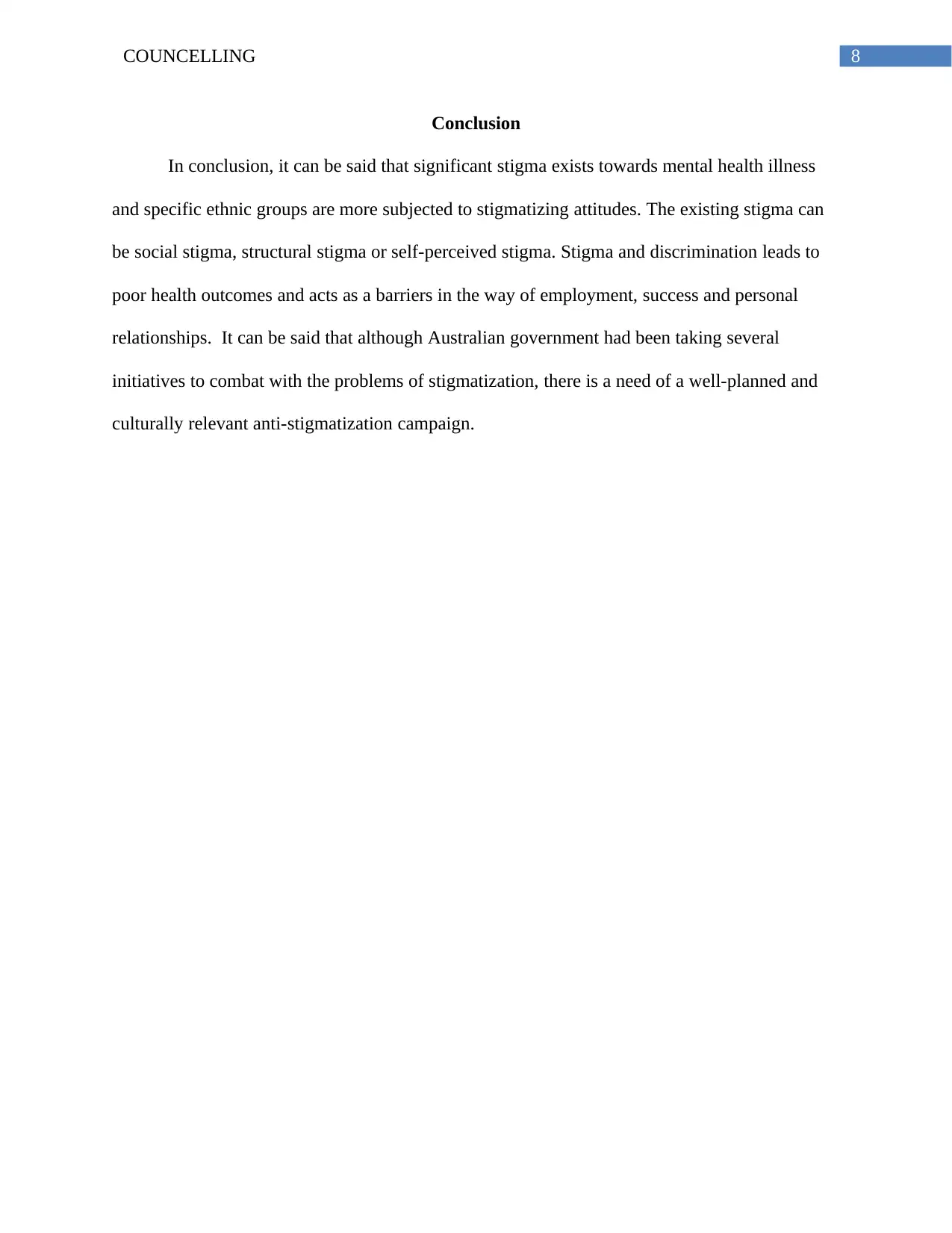
8COUNCELLING
Conclusion
In conclusion, it can be said that significant stigma exists towards mental health illness
and specific ethnic groups are more subjected to stigmatizing attitudes. The existing stigma can
be social stigma, structural stigma or self-perceived stigma. Stigma and discrimination leads to
poor health outcomes and acts as a barriers in the way of employment, success and personal
relationships. It can be said that although Australian government had been taking several
initiatives to combat with the problems of stigmatization, there is a need of a well-planned and
culturally relevant anti-stigmatization campaign.
Conclusion
In conclusion, it can be said that significant stigma exists towards mental health illness
and specific ethnic groups are more subjected to stigmatizing attitudes. The existing stigma can
be social stigma, structural stigma or self-perceived stigma. Stigma and discrimination leads to
poor health outcomes and acts as a barriers in the way of employment, success and personal
relationships. It can be said that although Australian government had been taking several
initiatives to combat with the problems of stigmatization, there is a need of a well-planned and
culturally relevant anti-stigmatization campaign.
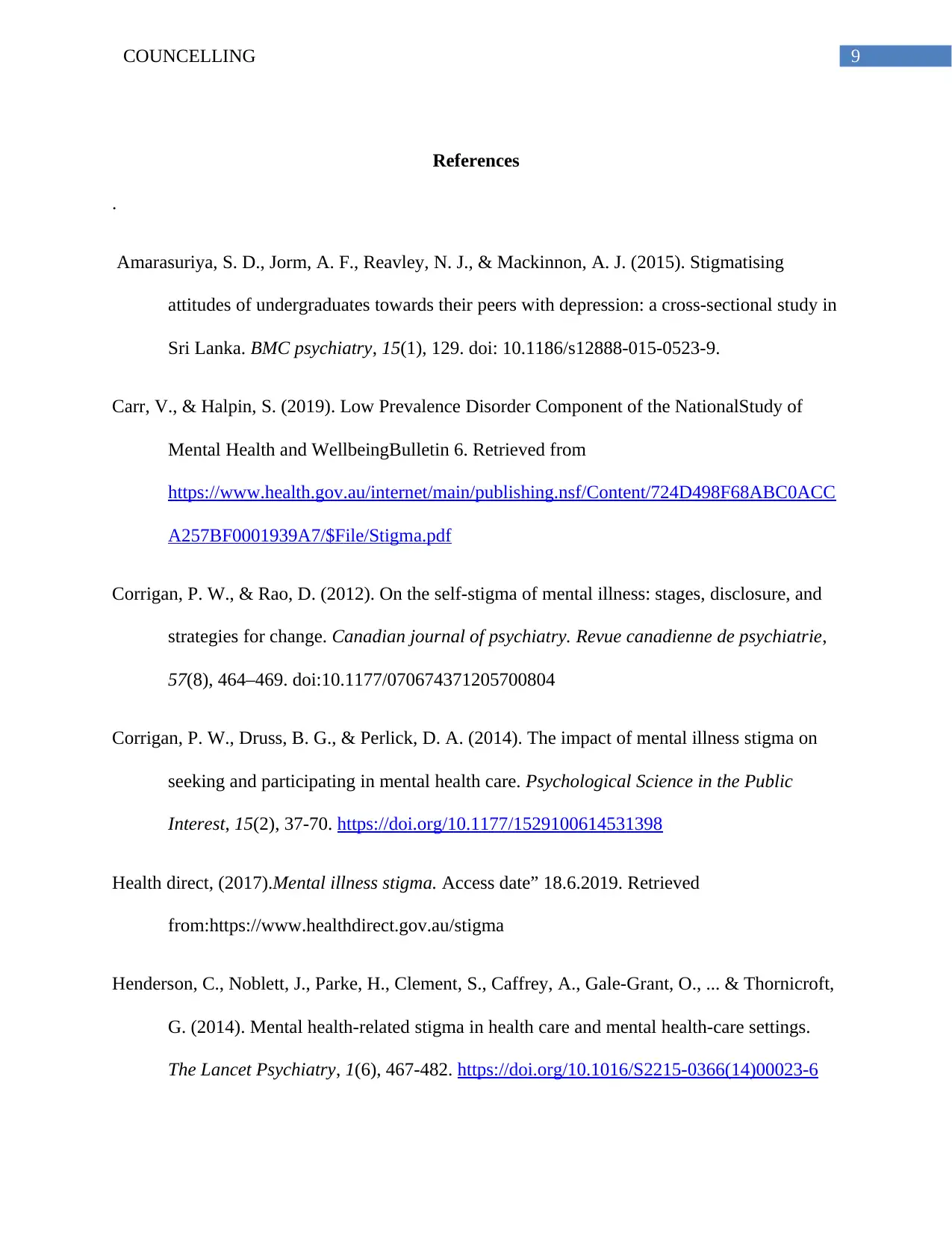
9COUNCELLING
References
.
Amarasuriya, S. D., Jorm, A. F., Reavley, N. J., & Mackinnon, A. J. (2015). Stigmatising
attitudes of undergraduates towards their peers with depression: a cross-sectional study in
Sri Lanka. BMC psychiatry, 15(1), 129. doi: 10.1186/s12888-015-0523-9.
Carr, V., & Halpin, S. (2019). Low Prevalence Disorder Component of the NationalStudy of
Mental Health and WellbeingBulletin 6. Retrieved from
https://www.health.gov.au/internet/main/publishing.nsf/Content/724D498F68ABC0ACC
A257BF0001939A7/$File/Stigma.pdf
Corrigan, P. W., & Rao, D. (2012). On the self-stigma of mental illness: stages, disclosure, and
strategies for change. Canadian journal of psychiatry. Revue canadienne de psychiatrie,
57(8), 464–469. doi:10.1177/070674371205700804
Corrigan, P. W., Druss, B. G., & Perlick, D. A. (2014). The impact of mental illness stigma on
seeking and participating in mental health care. Psychological Science in the Public
Interest, 15(2), 37-70. https://doi.org/10.1177/1529100614531398
Health direct, (2017).Mental illness stigma. Access date” 18.6.2019. Retrieved
from:https://www.healthdirect.gov.au/stigma
Henderson, C., Noblett, J., Parke, H., Clement, S., Caffrey, A., Gale-Grant, O., ... & Thornicroft,
G. (2014). Mental health-related stigma in health care and mental health-care settings.
The Lancet Psychiatry, 1(6), 467-482. https://doi.org/10.1016/S2215-0366(14)00023-6
References
.
Amarasuriya, S. D., Jorm, A. F., Reavley, N. J., & Mackinnon, A. J. (2015). Stigmatising
attitudes of undergraduates towards their peers with depression: a cross-sectional study in
Sri Lanka. BMC psychiatry, 15(1), 129. doi: 10.1186/s12888-015-0523-9.
Carr, V., & Halpin, S. (2019). Low Prevalence Disorder Component of the NationalStudy of
Mental Health and WellbeingBulletin 6. Retrieved from
https://www.health.gov.au/internet/main/publishing.nsf/Content/724D498F68ABC0ACC
A257BF0001939A7/$File/Stigma.pdf
Corrigan, P. W., & Rao, D. (2012). On the self-stigma of mental illness: stages, disclosure, and
strategies for change. Canadian journal of psychiatry. Revue canadienne de psychiatrie,
57(8), 464–469. doi:10.1177/070674371205700804
Corrigan, P. W., Druss, B. G., & Perlick, D. A. (2014). The impact of mental illness stigma on
seeking and participating in mental health care. Psychological Science in the Public
Interest, 15(2), 37-70. https://doi.org/10.1177/1529100614531398
Health direct, (2017).Mental illness stigma. Access date” 18.6.2019. Retrieved
from:https://www.healthdirect.gov.au/stigma
Henderson, C., Noblett, J., Parke, H., Clement, S., Caffrey, A., Gale-Grant, O., ... & Thornicroft,
G. (2014). Mental health-related stigma in health care and mental health-care settings.
The Lancet Psychiatry, 1(6), 467-482. https://doi.org/10.1016/S2215-0366(14)00023-6
Secure Best Marks with AI Grader
Need help grading? Try our AI Grader for instant feedback on your assignments.
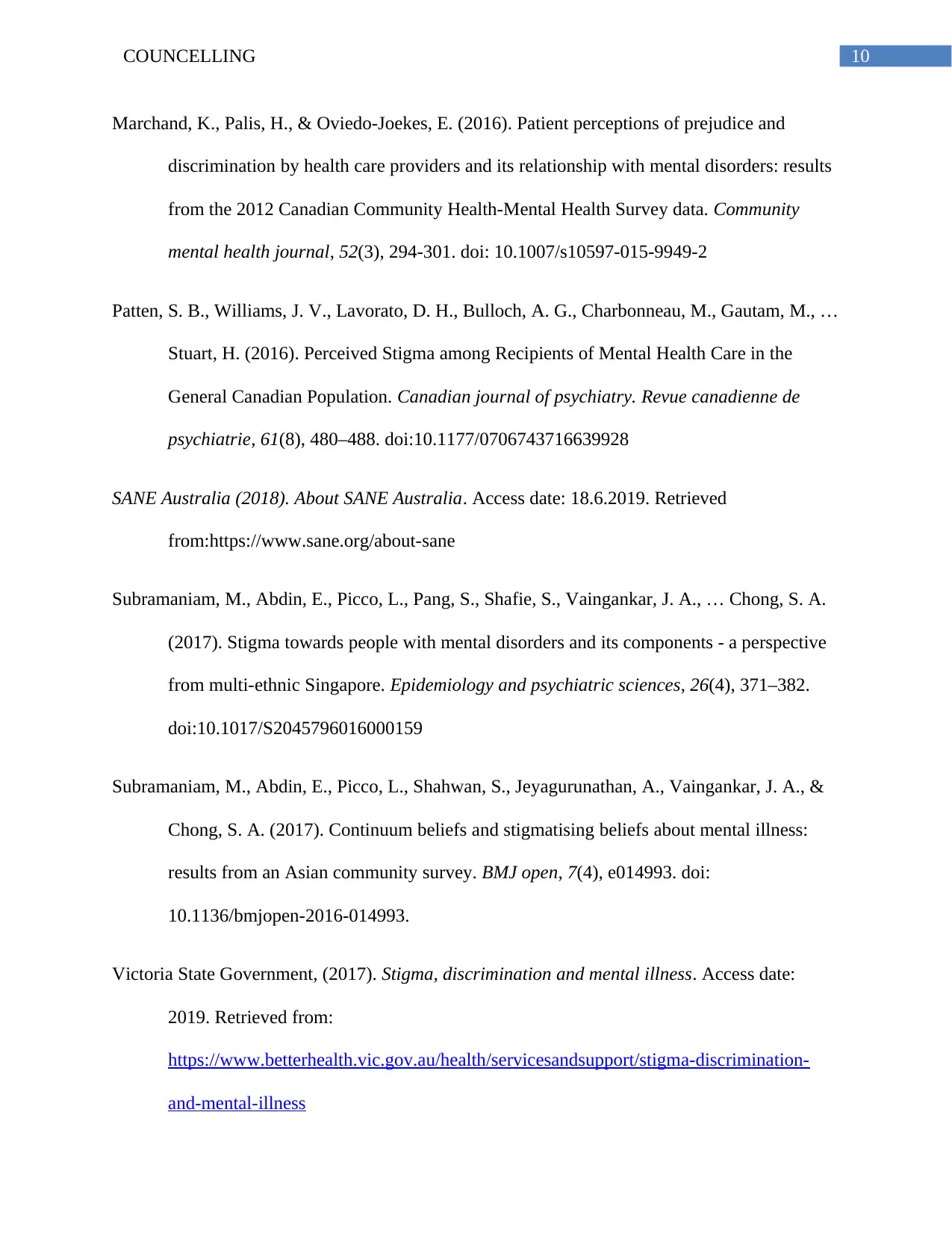
10COUNCELLING
Marchand, K., Palis, H., & Oviedo-Joekes, E. (2016). Patient perceptions of prejudice and
discrimination by health care providers and its relationship with mental disorders: results
from the 2012 Canadian Community Health-Mental Health Survey data. Community
mental health journal, 52(3), 294-301. doi: 10.1007/s10597-015-9949-2
Patten, S. B., Williams, J. V., Lavorato, D. H., Bulloch, A. G., Charbonneau, M., Gautam, M., …
Stuart, H. (2016). Perceived Stigma among Recipients of Mental Health Care in the
General Canadian Population. Canadian journal of psychiatry. Revue canadienne de
psychiatrie, 61(8), 480–488. doi:10.1177/0706743716639928
SANE Australia (2018). About SANE Australia. Access date: 18.6.2019. Retrieved
from:https://www.sane.org/about-sane
Subramaniam, M., Abdin, E., Picco, L., Pang, S., Shafie, S., Vaingankar, J. A., … Chong, S. A.
(2017). Stigma towards people with mental disorders and its components - a perspective
from multi-ethnic Singapore. Epidemiology and psychiatric sciences, 26(4), 371–382.
doi:10.1017/S2045796016000159
Subramaniam, M., Abdin, E., Picco, L., Shahwan, S., Jeyagurunathan, A., Vaingankar, J. A., &
Chong, S. A. (2017). Continuum beliefs and stigmatising beliefs about mental illness:
results from an Asian community survey. BMJ open, 7(4), e014993. doi:
10.1136/bmjopen-2016-014993.
Victoria State Government, (2017). Stigma, discrimination and mental illness. Access date:
2019. Retrieved from:
https://www.betterhealth.vic.gov.au/health/servicesandsupport/stigma-discrimination-
and-mental-illness
Marchand, K., Palis, H., & Oviedo-Joekes, E. (2016). Patient perceptions of prejudice and
discrimination by health care providers and its relationship with mental disorders: results
from the 2012 Canadian Community Health-Mental Health Survey data. Community
mental health journal, 52(3), 294-301. doi: 10.1007/s10597-015-9949-2
Patten, S. B., Williams, J. V., Lavorato, D. H., Bulloch, A. G., Charbonneau, M., Gautam, M., …
Stuart, H. (2016). Perceived Stigma among Recipients of Mental Health Care in the
General Canadian Population. Canadian journal of psychiatry. Revue canadienne de
psychiatrie, 61(8), 480–488. doi:10.1177/0706743716639928
SANE Australia (2018). About SANE Australia. Access date: 18.6.2019. Retrieved
from:https://www.sane.org/about-sane
Subramaniam, M., Abdin, E., Picco, L., Pang, S., Shafie, S., Vaingankar, J. A., … Chong, S. A.
(2017). Stigma towards people with mental disorders and its components - a perspective
from multi-ethnic Singapore. Epidemiology and psychiatric sciences, 26(4), 371–382.
doi:10.1017/S2045796016000159
Subramaniam, M., Abdin, E., Picco, L., Shahwan, S., Jeyagurunathan, A., Vaingankar, J. A., &
Chong, S. A. (2017). Continuum beliefs and stigmatising beliefs about mental illness:
results from an Asian community survey. BMJ open, 7(4), e014993. doi:
10.1136/bmjopen-2016-014993.
Victoria State Government, (2017). Stigma, discrimination and mental illness. Access date:
2019. Retrieved from:
https://www.betterhealth.vic.gov.au/health/servicesandsupport/stigma-discrimination-
and-mental-illness

11COUNCELLING
Yoshioka, K., Reavley, N. J., MacKinnon, A. J., & Jorm, A. F. (2014). Stigmatising attitudes
towards people with mental disorders: results from a survey of Japanese high school
students. Psychiatry research, 215(1), 229-236.
Yoshioka, K., Reavley, N. J., MacKinnon, A. J., & Jorm, A. F. (2014). Stigmatising attitudes
towards people with mental disorders: results from a survey of Japanese high school
students. Psychiatry research, 215(1), 229-236.
1 out of 12
Related Documents
Your All-in-One AI-Powered Toolkit for Academic Success.
+13062052269
info@desklib.com
Available 24*7 on WhatsApp / Email
![[object Object]](/_next/static/media/star-bottom.7253800d.svg)
Unlock your academic potential
© 2024 | Zucol Services PVT LTD | All rights reserved.





